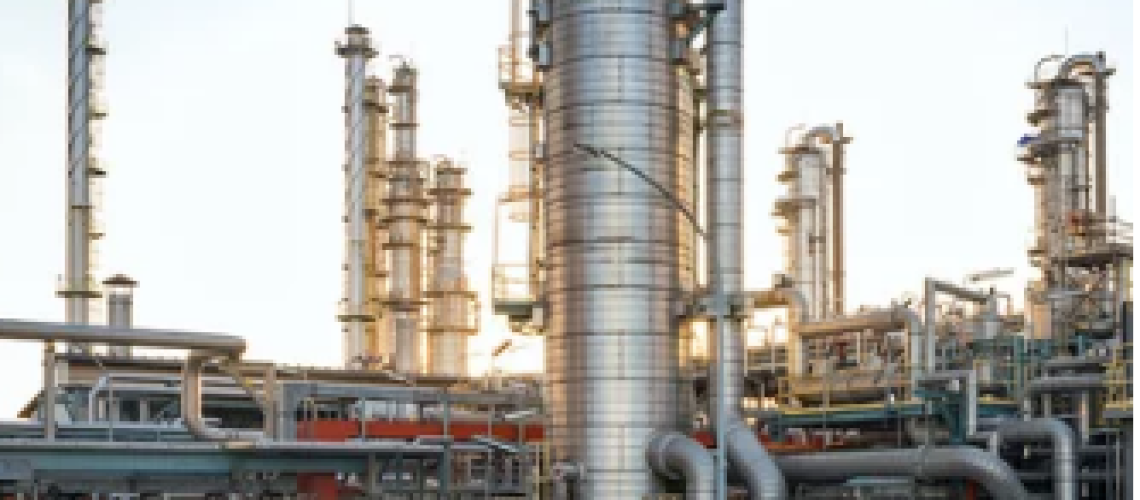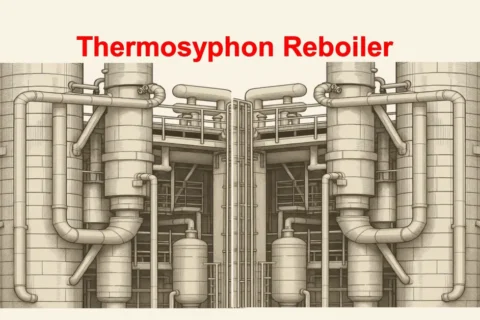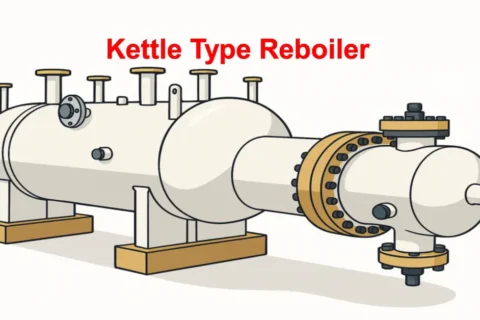Distillation is the most widely used separation process in oil refineries and chemical process industries. It is normally used to separate a mixture of materials to obtain one or more desired products which are achieved by the contact between the rising vapours and the liquid flowing down inside the distillation tower. To promote intimate contact between the vapour and liquid, the distillation column contains internal devices. The internal devices may be grouped into two general categories: Tray-type and Packing-type. More about distillation and types, please view the blog “ Distillation and its Types”.
[amazon_auto_links id=”3259″]
In this blog, we have discussed tray-type internals. Three types of cross-flow trays are the most commonly used type of vapour and liquid contactors in the distillation columns. In a cross-flow type, the liquid flows across the tray, and the vapours rise up through the plate. The flowing liquid is transferred from the plate to the plate through downcomers. A certain level of the liquid is retained on the plate by an outlet weir.

The most widely applied trays in process industries are 1. Bubble cap trays, 2. Sieve trays and 3. Valve trays.
1. Bubble Cap Trays
In this tray, vapours rise up through risers or chimneys into a cap, then come out from slots or holes in a cap and bubble through the surrounding liquid on the tray. Vapours and liquids are in total contact for their mixing and mass transfer. Liquid flows over the caps on the tray from the upper downcomer to the outlet weir and downcomer to the tray below. A liquid head is maintained on the tray by an outlet weir near the downcomer.
[amazon_auto_links id=”3259″]
Advantages
- Excellent Mixing since gas/vapour travels through the pool of liquid.
- Very little probability of weeping. Weeping is a phenomenon where the gas flow rate is very low and the liquid flow rate is very high due to which, the liquid simply runs through the plate downwards without any mixing with the gas.
- The bubble cap tray has a built-in seal that prevents liquid drainage at low gas-flow rates. The bubble cap tray is able to operate at low vapour and liquid rates because liquid and foam are trapped on the tray to a depth at least equal to the weir height.
- There is no weeping phenomenon in bubble cap trays.
Disadvantages
- The disadvantages associated with bubble trays are high-pressure gradient through the trays
- Bubble cap trays are costly as compared to sieve and valve-type trays.
- Bubble cap trays require more space on the trays thus the lower number of openings on the single trays deck.
- Extensive labour and more materials are required to manufacture bubble-cap trays.
The working of bubble cap trays can be seen in Fig. 01 below.

2. Sieve Tray
The sieve plate is the simplest type of cross-flow plate. The tray contains round small holes, and perforations (⅛ to 1-in.) punched on the tray deck. Vapour rises through the small perforations on the tray floor and bubbles through the liquid in a fairly uniform manner. The liquid then flows across the tray floor over the weir, through the downcomer to the tray below.
The holes on the tray give a multi-orifice effect. The vapour velocity keeps the liquid from flowing down through the holes. Liquid flow is transported down the tower by downcomers and weirs to the overflow device on the side of the plate.
In sieve plates, the liquid is prevented from flowing through the sieve tray perforations by the upward-flowing action of the gas; thus, when the gas flow is low, it is possible for some or all of the liquid to drain through the perforations and in effect bypass portions of the contacting zone. This phenomenon is called weeping.
The function of a tray is to mix the vapour and liquid together to form a foam. Vapours bubble up through the tray sieve holes, where the vapour comes into intimate contact with the liquid. The fluid on the tray is a mixture of vapour and liquid in the form of froth or foam. This foam should separate back into a vapour and a liquid on the tray and in the downcomer. If the foam cannot drain quickly from a downcomer onto the tray below, then the foamy liquid will back up onto the tray above. This is called Flooding.
Advantages
- Sieve trays are simple in design and lower in cost, than both bubble cap and valve-type trays.
- Sieve trays have easy operation, maintenance, and cleaning.
- Pressure drop across the sieve trays is lower as compared to the other trays.
Disadvantages
- Sieve trays show poor performance at turndown rates because there is no positive vapour-liquid seal, and at low flow rates liquid will ‘‘weep’’ through the holes, reducing the tray efficiency.
- The vertically exiting vapours in sieve trays create higher froth heights, thus increasing the potential for liquid entertainment.
The working of sieve trays can be seen in Fig. 02 below.

3. Valve Trays
The openings in valve trays are covered with liftable caps that adjust themselves according to the vapour flow. Tray valves or caps close off at a low vapour rate, thus stopping the liquid from moving down from the tray. As the vapour rate increases, the valve lifts, and the open area for vapour flow also increase.
In valve trays the openings may be varied by the vapour flow, so the trays can operate over a wide range of flow rates with high separation efficiency and large flexibility. Because of their flexibility and reasonable price, valve trays are tending to replace bubble-cap trays.
The valve plate is designed to minimize this drainage, or “weeping,” since the valve tends to close as the gas flow becomes lower, the total orifice area varying to maintain a dynamic-pressure balance across the plate.
The valves on the trays can be fixed or moving. The fixed valves are permanently open while the moving valves adjust themselves according to the vapours flowing up through the tray holes as discussed above.
[amazon_auto_links id=”3259″]
Advantages
- Very little probability of weeping since the valve opening is proportional to the vapour flow rate, thus the lower the vapour flow rate, the lesser the opening.
- Valve trays are flexible and can be used at varying rates and feed compositions.
- As the area for vapour flow varies with the flow rate, valve plates can operate efficiently at lower flow rates than sieve plates, with the valves closing at low vapour rates.
- Valve trays are cheaper than bubble cap trays and slightly more costly than sieve trays.
- In valve trays, the pressure drop is lower than in bubble cap trays. Higher vapour rates mean high differential pressure.
Disadvantages
- On a moving-valve tray, some of the valves begin to close when the vapour flow rate decreases, thus reducing the effective area of the tray.
- Moving valve trays are more prone to fouling than fixed valves because they typically have more surface area available for the deposition of contaminants. This would be a serious concern for columns operating in severe conditions of dirt and debris, various forms of corrosion, and dew point salt formation.
- As moving valves open and close, the valve legs can contact the edges of the orifice, which can cause erosion and increase corrosion.
The working of valve trays can be seen in Fig. 03 below.

For further information, discussion and queries please comment in the box below or contact us at admin@ or follow us on Facebook & LinkedIn.






3 thoughts on “Types of Trays in Distillation Columns”
I’m Mahendra Singh mechanical forman abrod and india 17years experience then Hydrojetting supervisor experience same pls.nead to any one pls call me me
my mobile nomber.+919456376405
oil and gas plant